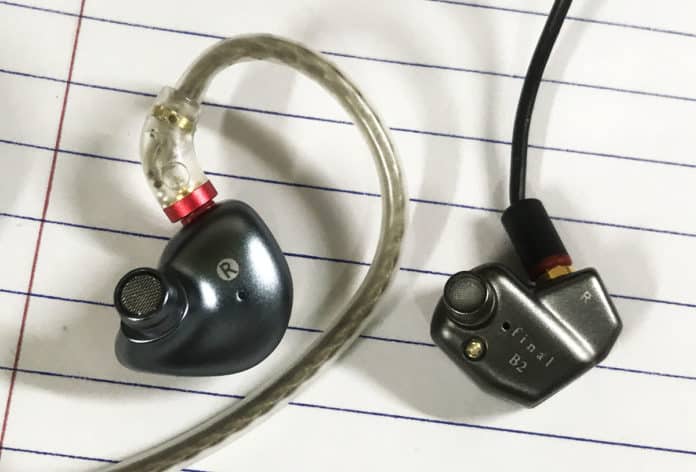One of my favorite IEMs from earlier this year was the FiiO FH5. With an affordable price point, this audiophile IEM took the internet by storm with its level of detail and energetic dynamics. However, recently, Final Audio released its B-Series, and with it, the Final Audio B2. At a similar price as the FH5, can it compete with the FH5? Today, let’s take a closer look with this Final Audio B2 vs Fiio FH5 Review.
Final Audio B2 vs FiiO FH5 Review
In the Box
| Final Audio B2 | Fiio FH5 |
| Final Audio B2 IEMs | FiiO FH5 |
| Detachable MMCX cable with 3.5 mm connector | Detachable MMCX cable with 3.5 mm connector |
| Earhooks | Tuning eartips (4 different tunings, 3 sizes each) |
| Eartips (Final Audio E-Type tips) | Cleaning tool |
| Cable removing grip | Hard shell clasping case |
| Silicone carrying case | Soft zipping case |
| Documentation | Documentation |
Design
Look and Feel
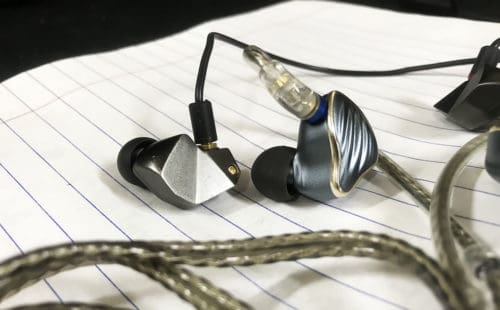
Both the Final Audio B2 and the FiiO FH5 have classy, aesthetically pleasing looks. On one hand, the driver housing of the B2 has a mature, geometric shape. By contrast, the FH5 has a flowier, shape with roundness to its edges. Both have a matte finish, and are made of aluminum. As a result, they both feel equally sturdy and well made. However, the cable of the FH5 seems slightly more reinforced than the B2, with thick a thick aluminum housing for its 3.5 mm connector and thick plastic around its MMCX connector. By contrast, the connectors of the B2 have a smaller footprint, but have less reinforcement.
Comfort and Fit
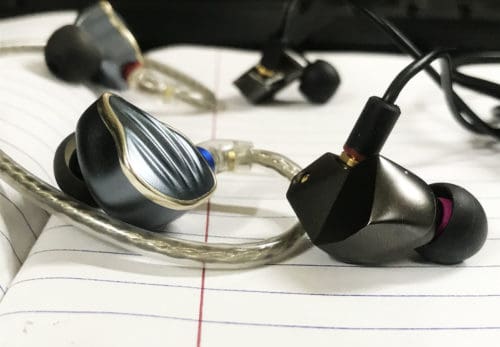
Both the Final Audio B2 and the FiiO FH5 fit remarkably easily in the ears. They are lightweight and work easily with the contour of the ear. One big difference is that the B2 has detachable earhooks, whereas the FH5 has fixed earhooks. And while the earhooks of the FH5 help to keep them in place, I didn’t feel the need to use them with the B2. Its cable wrapped behind my ears with ease, and maintained a good seal, even without the hooks.
Cable

The cables of the Final Audio B2 and the FiiO FH5 are similar in layout. Both connect to their respective earphones via MMCX connectors. The wires of the individual sides are twisted within the same jacket. Finally when the left and right side meet, they remain in their individual jackets and run alongside each other without twisting or braiding. Finally, both terminate to their respective 3.5 mm connector. The most obvious difference between them is the material of their jackets. On one hand, the jacket of the B2 is thin and very malleable so it is easy to control and manipulate in space. By contrast, the jacket of the FH5, while see-through, is thicker, stiffer, and a little bit more difficult to control. However, both are about the same length.

Drivers
The Final Audio B2 and the FiiO FH5 have different driver configurations. On one hand, the B2 has just one balanced armature driver. On the other hand, the FH5 has a hybrid driver design, featuring a dynamic driver and three balanced armature drivers.
Sound
Low Frequencies
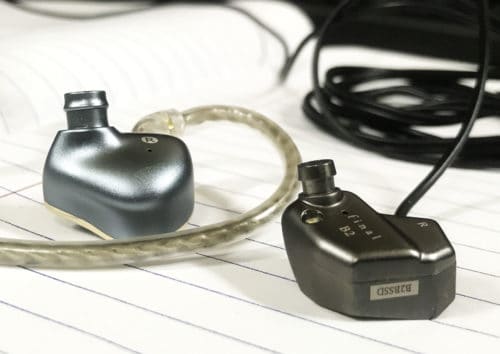
The low frequencies of the Final Audio B2 and the FiiO FH5 are quite different from one another. The B2 has a more even, natural sound, whereas the FH5 has a little more depth and character. The B2 has a small boost around what sounded like 60 Hz, which provided a little bit of extra punch. On the other hand, the FH5 has a boost in the sub region around what sounded like 30 Hz and again at what sounded like 150 Hz. As a result, its low frequency response sounded louder in the mix, and had a little bit more depth to it.
For example, when I was listening to the song Normal by Conor Oberst and the Mystic Valley Band, the kick drum at the start of the song had a greater sense of realism and harmonic complexity with the Final Audio B2. However, by comparison, it had more level in the mix, more depth, and more character with the FiiO FH5. As a result, I enjoyed the Final Audio B2’s low end for jazz, classical, and for genres requiring more realism there. On the other hand, I enjoyed the FiiO FH5 more for rock, hip-hop, pop, and genres that benefit from a bigger bass boost.
Middle Frequencies
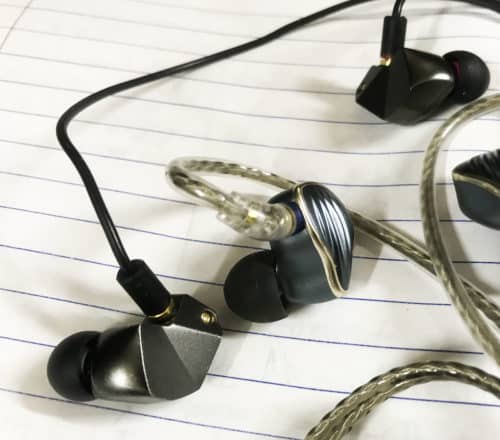
The midrange of the Final Audio B2 and the FiiO FH5 have a similar sense of detail and harmonic complexity, but have different shapes. On one hand, the B2 puts more emphasis on the vocals, and thus seems to have a slightly quieter middle midrange. On the other hand, while the FH5 does have some vocal emphasis, it feels a little bit more geared toward middle midrange instruments. Both IEMs have boosts in the high-mids. The B2 has a boost a little bit lower, around what sounded like between 2-4 kHz. The FH5’s boost was around 5 kHz, and was a little bit less pronounced.
For example, when I was listening to the song Sweet Spot by Kim Petras, the top, high-mid melodic synths sat more forward in the mix with the B2, as did the vocal. On the other hand, more of the middle midrange parts of the synths had body with the FH5. Comparing these midranges was interesting because the FH5’s midrange felt more balanced, but the B2’s midrange had better separation.
High Frequencies

The high frequencies of the Final Audio B2 and the FiiO FH5 have emphasis and harmonic complexity. However, the highs seemed a little bit more emphasized with the B2, whereas they felt a little bit more even with the FH5. The B2 had extra emphasis around what sounded like 7 kHz, providing lots of articulation. Additionally, it had a cut around what sounded like 8-9 kHz, which made it a little less texture but helped it avoid harshness. On the other hand, the FH5 had emphasis in the upper octave around what sounded like 10-13 kHz. As a result, it was a little bit more even sounded, but sat a little quieter in the mix. It also had a greater sense of emphasized air, whereas the B2’s air was more subtle.
For example, when I was listening to the song 1919 by Terri Lyne Carrington and Lewis Porter, both the Final Audio B2 and the FiiO FH5 were able to reproduce the unique character of each cymbal. However, the cymbals seemed to have more space around them with the B2. They sounded a little bit quieter with the FH5, but had a more realistic tonality. WIth the B2, their attacks were slightly emphasized, and their texture was a little ducked. With both IEMs, the cymbals had a nice feeling of extension to them.
Soundstage
The soundstage of the Final Audio B2 and the FiiO FH5 are great at their price point. While the B2 has a more spacious sense of width and depth, the FH5 has a more dramatic feeling of the height.
For example, when I was listening to the song Good Life by Sammy Rae, which has a pretty thick arrangement once the song kicks in, there was greater contrast between the intimate vocals and the far off drums and horns with the B2. However, at the same time, there was better contrast between the lows of the bass and kick and the highs of the cymbals and vocals with the FH5.
Overview
Overall, the Final Audio B2 and the Fiio FH5 are high performing IEMs at their price point. Both fit super comfortably, have a good look and are durable. Their sound signatures are a bit different, which is why they are good for different genres. The B2 is best for jazz, classical and thick songwriter arrangements. On the other hand, the FH5 is best for hip-hop, rock, and pop music.
The Final Audio B2 and the FiiO FH5 are available for the best price here:
MajorHiFi may receive commission through retail offers.
MAJORHIFI may receive commissions from retail offers.


